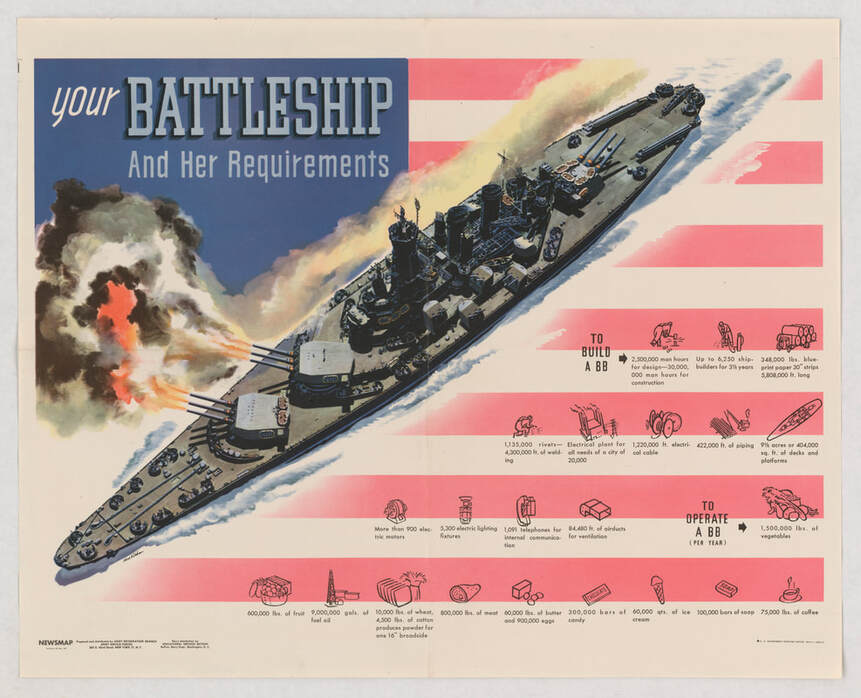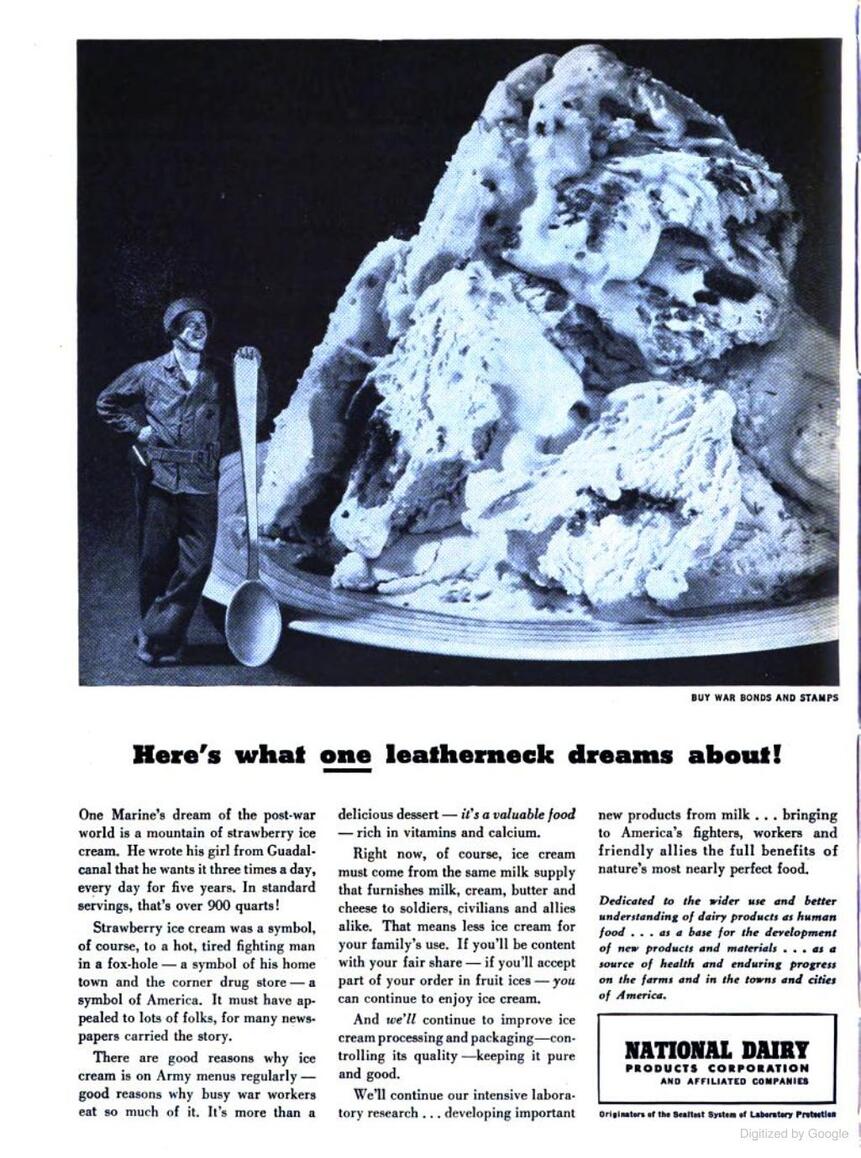|
Last World War Wednesday, we looked at the use of ice cream in the U.S. Navy during the First World War, especially aboard hospital ships. Now it's time for a reprise! By the Second World War, ice cream was firmly entrenched aboard Naval vessels. So much so, that battleships and aircraft carriers were actually outfitted with ice cream machinery, and by the end of the war the Navy was training sailors in their uses through special classes. The above propaganda poster, courtesy the National Archives, outlines all of the requirements to build a battleship. "Your Battleship and Her Requirements" may have been targeted toward factory workers, but I think it is more likely this poster was designed to impress upon ordinary Americans the extraordinary amount of materials and supplies needed to keep a battleship in fighting trim. What I found particularly interesting, was that among the supplies listed, alongside fruits and vegetables and meat and even candy, was 60,000 quarts of ice cream! Smaller vessels, such as destroyer escorts and submarines, did not have the space for their own ice cream making machinery, although they did have freezers. In fact, it became common for destroyer escorts and PT boats to rescue downed pilots (the aircraft carries were too big for the job) and "ransom" them for ice cream. Last week a brand new food podcast debuted for American Public Television called "If This Food Could Talk," and I'm so pleased to say I was featured in the first episode, "Frozen in Time: Ice Cream and America's Past." I had a blast doing the research for that episode's interview, which has inspired these two recent World War Wednesday posts. Have a listen if you want to learn more about ice cream in American history, and especially the story of ice cream in the Navy. But while I was doing the research, I kept running across references to ice cream as a health food! The National Dairy Council really leaned into the notion of ice cream and the armed forces. This advertisement reads, "There's a reason why the U.S. Navy serves Ice Cream. America's favorite dairy food - Ice Cream - is an important source of vitamins, proteins and minerals." The ad goes on: "Navy menus don't just happen! Every food included in the diet of Navy personnel, ashore or afloat, is there for a purpose. It is there because it has been okayed by the staff of experts at the Subsistence Research Laboratory of the U.S. Navy in Chicago for making an important contribution to the health, strength, and morale fighters must have to win! "These highly skilled and trained technicians at the laboratory know every condition under which the men live - know their requirements - and make sure exactly what each food will do for those men before it is approved. "That is why it is significant that ice cream ranks so high on Navy menus. It is not only a favorite food, but it also supplies valuable vitamins, proteins, and minerals. For that reason, wherever practical, the Navy gets ice cream! "Throughout the world - over the seven seas - the talents of the Subsistence Research Laboratory of the U.S. Navy are directed to keeping our Navy a strong, healthy, hard-hitting force; making sure it gets the foods the men like - the foods they need for victory! "Ice Cream Is a Fighting Food "Ice cream is a favorite with all branches of our armed forces - and it is important that they get this valuable food. So fi you aren't always able to get all the ice cream you want - remember, you're 'sharing' this nutritious food with our fighters." The National Dairy Council might be just a SMIDGE biased in this regard, but certainly the federal government ranked milk, and by extension milk products, very highly in terms of nutrition during the Second World War, notably as part of the Basic 7 nutrition recommendations. This was almost certainly a holdover from the Progressive Era's take on milk as the "perfect food" - combining proteins, carbohydrates, and fats all in one. We see this in another advertisement, this time by the National Dairy Products Corporation. The National Dairy Council is an industry-funded research and marketing organization. But the National Dairy Products Corporation would later become Kraft Foods. "Here's what one leatherneck dreams about! "One Marine's dream of the post-war world is a mountain of strawberry ice cream. He wrote his girl from Guadalcanal that he wants it three times a day, every day for five years. In standard servings, that's over 900 quarts! "Strawberry ice cream was a symbol, of course, to a hot, tired fighting man in a fox-hole - a symbol of his home town and the corner drug store - a symbol of America. It must have appealed to lots of folks, for many newspapers carried the story. "There are good reasons why ice cream is on Army menus regularly - good reason why busy war workers eat so much of it. It is more than a delicious dessert - it's a valuable food - rich in vitamins and calcium. "Right now, of course, ice cream must come from the same milk supply that furnishes milk, cream, butter and cheese to soldiers, civilians and allies alike. That means less ice cream for your family's use. If you'll be content with your fair share - if you'll accept part of your order in fruit ices - you can continue to enjoy ice cream. "And we'll continue to improve ice cream processing and packaging - controlling its quality - keeping it pure and good. "We'll continue our intensive laboratory research... developing important new products from milk... bringing to America's fighters, workers and friendly allies the full benefits of nature's most nearly perfect food." Here you can see the "perfect food" rhetoric in action! And interestingly, this one touts the role of ice cream in the Army as well. In my opinion ice cream, for all the rhetoric about nutrition, had far more to do with morale than anything else. But there is some truth to the idea that as a dessert it was superior to cake or pie. For one thing, ice cream does have some protein, in addition to a decent amount of fat. Full fat dairy is generally proven to be more filling and satisfying and protein and fat slow down the absorption of sugar directly into the bloodstream, making the "energy-giving" properties of carbohydrates longer-lasting and less likely to make you crash (unlike cake and cookies). That being said, viewing ice cream as a health food is questionable today. But in the period, the discoveries of vitamins and minerals like calcium were cutting-edge, and any food containing those essential nutrients was considered good for you. Ice cream also fit neatly into ideas (unconscious or otherwise) of White supremacy and American (i.e. Anglo-Saxon) culture. As the National Dairy Products Corporation marketing team wrote, ice cream was "a symbol of America." When combined with soda fountains (the wholesome, if sugary, alternative to saloons and beer halls), ice cream seemed to represent the best of America - slim, good-looking, young, White America, that is. Today, ice cream's modern accessibility has given us ice cream alternatives aplenty, especially for folks who can't consume dairy. Ice cream's ubiquity has also meant some of its luster has faded. But at a time of extreme stress - the violence of the theater of war, the privations of home front rationing, the push to mobilize for total war, the fear of invasion - ice cream provided a moment of bliss in the midst of uncertainty. Ice cream is still an essential tradition aboard Naval vessels today. When you're miles from home for months at a time, anything that seems like a treat gives morale a boost. It's still a treasured treat in our household, whether homemade or store bought (if you find yourself in upstate New York - do yourself a favor and seek out Stewart's Shops. They have the best commercial ice cream around). What does ice cream mean to you? The Food Historian blog is supported by patrons on Patreon! Patrons help keep blog posts like this one free and available to the public. Join us for awesome members-only content like free digitized cookbooks from my personal collection, e-newsletter, and even snail mail from time to time! A special patrons-only post is coming tomorrow with more on ice cream in World War II - this time featuring Elsie the Cow! Join now for as little as $1/month.
Don't like Patreon? Leave a tip!
1 Comment
Kady Kloster
1/20/2024 10:56:38 am
I love this article. I am a history teacher and this is exactly what students need to hook them into learning about history. Thank you.
Reply
Your comment will be posted after it is approved.
Leave a Reply. |
AuthorSarah Wassberg Johnson has an MA in Public History from the University at Albany and studies early 20th century food history. Archives
July 2024
Categories
All
|




 RSS Feed
RSS Feed